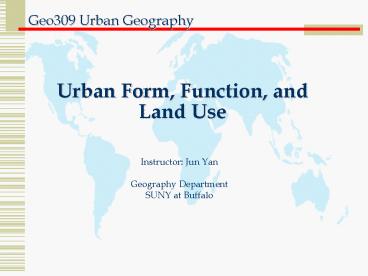Urban Form, Function, and Land Use - PowerPoint PPT Presentation
1 / 22
Title:
Urban Form, Function, and Land Use
Description:
History. Von Th nen' Agricultural Land Use Theory: in 1826. A German farmer and ... CBD, located at the city center (point), have all the employment opportunity ... – PowerPoint PPT presentation
Number of Views:173
Avg rating:3.0/5.0
Title: Urban Form, Function, and Land Use
1
Urban Form, Function, and Land Use
Geo309 Urban Geography
Instructor Jun Yan Geography Department SUNY at
Buffalo
2
Last Class
- The Industrial City (1875-1920)
- Spatial reorganization of urban space so rapid
and so dramatic - Highly specialized land use segregation
- Land use zoning
- Impact of streetcars and rapid transit system
- CBD
- Functional organizations
- Core-Frame Structure of CBD
3
Outline
- Land Use Modeling
4
History
- Von Thünen Agricultural Land Use Theory in 1826
- A German farmer and amateur economist
- To explain the patterns of the distribution of
the agricultural land use and land value - Ring-type land use structure
- William Alonsos Urban Bit-Rent Theory
5
Utility
- Utility more desirable situation offers more
utility than less desirable situation - A replacement of revenue since in a lot of
cases the satisfaction of consuming certain goods
is hard to quantified by money - We often rank utility based our preference
- Utility maximization
- People generally choose the case in which the
utility can be maximized (best used) - Under certain conditions/constraints
6
Location Rent
- Also called as economic rent or ground rent
- Different from contract rent (e.g. the rent we
pay for renting an apartment) - Definition the surplus paid to land owner above
the minimum amount that would be necessary to use
the land at all. - Practically often calculated by minus the total
revenue with the total production and
transportation cost - So the lager the location rent of a piece of land
for a particular activity the higher and better
use for that land (bit-rent) different land uses
compete and the best wins - Foundation of Bit-Rent Theory
7
Urban Bit-Rent Theory Assumptions
- A flat featureless plain
- Transportation cost is a direct (linear) function
of linear distance between places, uniform in all
directions - CBD, located at the city center (point), have all
the employment opportunity - Economic Man people can make rational
decision-maximize utility - Perfect competition no one can affect the market
by his own activities
8
Bit-Rent Curve
- By definition
- Location Rent (LR) Total Revenue (TR)
Production Cost (PC) Transport Cost (TC) - TC Production (P) Transport Rate (TR)
Distance (D) - Assume TR, PC are constant, then LR is a function
of TC ? a function of Distance
9
Bit-Rent Curve
- Shape of Bit-Rent Curve (BRC)
- Central point has the highest LR
- Decline with Distance from center
- Bit-Rent Cone
10
Bit-Rent Curve
11
Bit-Rent Curves
- Different land use have different BRCs
- LR in center (CBD) retailingfactorieswarehouses
residential - Decline rate same order
- Explanation high accessibility of the center
12
Bit-Rent Curves
13
Modification Residential Distribution
- Contradictory observation
- Upper class outside city while working class near
city center - Additional assumption on household behavior
- Utility a combination of living space and
accessibility - Trade-off between these two/Trade-Off Model
- Upper class could trade off transport cost for
extra space - Lower class force to resident in high-cost
locations but have to minimize the living space
and household costs
14
Modification Multiple Foci
15
Urban Bit-Rent Theory Limitation
- Assumption of Perfect Competition
- Assumption of Economic Man
- Assumption of Free Entry
- A Static Model
16
Hoyts Sectoral Model
- Homer Hoyt (1939)
- Land use is a function of Direction
- In a given direction from center, a certain type
of land use will prevail - Land use mosaic consists of a series of sectors
radiating out from city center
17
Hoyts Sectoral Model
- Some regularities
- Rent varies primarily by radical sectors
- High-rent sectors often extend out from CBD
(linearly along major routes, high ground) - On either side of high-rent sectors are located
sectors with intermediate rents (buffer) - Low-rent sectors often locate the opposite of
high-rent sector - Industrial zone often surrounded by low-rent
sectors
18
Hoyts Sectoral Model
19
Hoyts Sectoral Model Explanation
- Upper class
- First pick away industrial belts and CBD along
certain routes (linear) and high ground - Upper class often like to move farther away to
the city edge and sell their old homes to
slightly lower class (generational shift) - Obsolescence functional, from, locational, style
- Middle class
- In the surrounding area of upper class residence
good name - Middle class then sell their old home to their
lower class (generational shift) - Vacancy Chain (filtering mechanism) social
ladder!!! ? neighborhood change
20
Hoyts Sectoral Model Explanation
21
So What Patterns in Buffalo Land Use?
22
Next Class
- Suburban Infill (1920-1945)
- Reading chp 5. pp 106118































